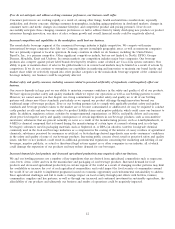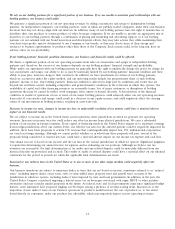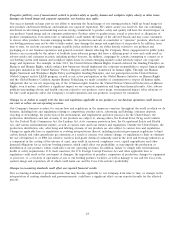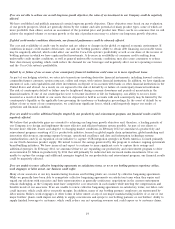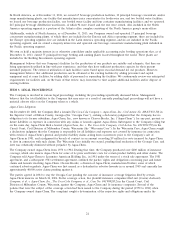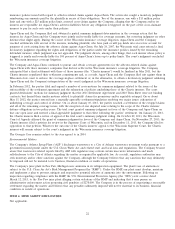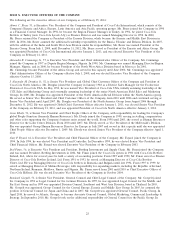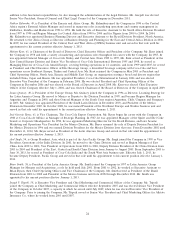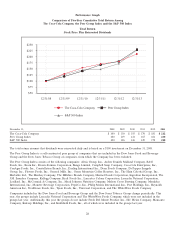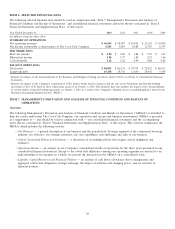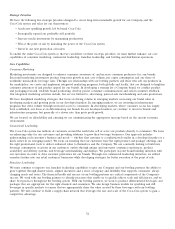Coca Cola 2013 Annual Report Download - page 24
Download and view the complete annual report
Please find page 24 of the 2013 Coca Cola annual report below. You can navigate through the pages in the report by either clicking on the pages listed below, or by using the keyword search tool below to find specific information within the annual report.insurance policies issued with regard to asbestos-related claims against Aqua-Chem. The action also sought a monetary judgment
reimbursing any amounts paid by the plaintiffs in excess of their obligations. Two of the insurers, one with a $15 million policy
limit and one with a $25 million policy limit, asserted cross-claims against the Company, alleging that the Company and/or its
insurers are responsible for Aqua-Chem’s asbestos liabilities before any obligation is triggered on the part of the cross-claimant
insurers to pay for such costs under their policies.
Aqua-Chem and the Company filed and obtained a partial summary judgment determination in the coverage action that the
insurers for Aqua-Chem and the Company were jointly and severally liable for coverage amounts, but reserving judgment on other
defenses that might apply. During the course of the Wisconsin insurance coverage litigation, Aqua-Chem and the Company
reached settlements with several of the insurers, including plaintiffs, who have paid or will pay funds into an escrow account for
payment of costs arising from the asbestos claims against Aqua-Chem. On July 24, 2007, the Wisconsin trial court entered a final
declaratory judgment regarding the rights and obligations of the parties under the insurance policies issued by the remaining
defendant insurers, which judgment was not appealed. The judgment directs, among other things, that each insurer whose policy is
triggered is jointly and severally liable for 100 percent of Aqua-Chem’s losses up to policy limits. The court’s judgment concluded
the Wisconsin insurance coverage litigation.
The Company and Aqua-Chem continued to pursue and obtain coverage agreements for the asbestos-related claims against
Aqua-Chem with those insurance companies that did not settle in the Wisconsin insurance coverage litigation. The Company
anticipated that a final settlement with three of those insurers (the ‘‘Chartis insurers’’) would be finalized in May 2011, but the
Chartis insurers repudiated their settlement commitments and, as a result, Aqua-Chem and the Company filed suit against them in
Wisconsin state court to enforce the coverage-in-place settlement or, in the alternative, to obtain a declaratory judgment validating
Aqua-Chem and the Company’s interpretation of the court’s judgment in the Wisconsin insurance coverage litigation.
In February 2012, the parties filed and argued a number of cross-motions for summary judgment related to the issues of the
enforceability of the settlement agreement and the exhaustion of policies underlying those of the Chartis insurers. The court
granted defendants’ motions for summary judgment that the 2011 Settlement Agreement and 2010 Term Sheet were not binding
contracts, but denied their similar motions related to plaintiffs’ claims for promissory and/or equitable estoppel. On or about
May 15, 2012, the parties entered into a mutually agreeable settlement/stipulation resolving two major issues: exhaustion of
underlying coverage and control of defense. On or about January 10, 2013, the parties reached a settlement of the estoppel claims
and all of the remaining coverage issues, with the exception of one disputed issue relating to the scope of the Chartis insurers’
defense obligations in two policy years. The trial court granted summary judgment in favor of the Company and Aqua-Chem on
that one open issue and entered a final appealable judgment to that effect following the parties’ settlement. On January 23, 2013,
the Chartis insurers filed a notice of appeal of the trial court’s summary judgment ruling. On October 29, 2013, the Wisconsin
Court of Appeals affirmed the grant of summary judgment in favor of the Company and Aqua-Chem. On November 27, 2013, the
Chartis insurers filed a petition for review in the Supreme Court of Wisconsin, and on December 11, 2013, the Company filed its
opposition to that petition. Whatever the outcome of the Chartis insurers’ appeal to the Wisconsin Supreme Court, the Chartis
insurers will remain subject to the court’s judgment in the Wisconsin insurance coverage litigation.
The Georgia Case remains subject to the stay agreed to in 2004.
Environmental Matters
The Company’s Atlanta Syrup Plant (‘‘ASP’’) discharges wastewater to a City of Atlanta wastewater treatment works pursuant to a
government-issued permit under the U.S. Clean Water Act and related state and local laws and regulations. The Company became
aware that wastewater-related reports filed by ASP with regulators may contain certain inaccurate information and made
self-disclosure to the City of Atlanta regarding the matter as required by applicable law. As a result, regulatory authorities may
seek monetary and/or other sanctions against the Company, although the Company believes that any sanctions that may ultimately
be imposed will not be material to its business, financial condition or results of operations.
The Company’s juice plant in Paw Paw, Michigan uses ammonia in its refrigeration equipment. The plant’s use of ammonia is
subject to the U.S. Clean Air Act’s Risk Management Program (the ‘‘RMP’’). Under the RMP, our plant must develop, maintain
and implement a plan to prevent, mitigate and respond to potential releases of ammonia into the environment. Following an
inspection regarding compliance with the RMP, the U.S. Environmental Protection Agency (the ‘‘EPA’’) sent a notice dated
March 12, 2013, to the Paw Paw juice plant alleging certain violations of the RMP and indicating that it may pursue an
administrative enforcement action proposing civil penalties of $278,000. The Company is in the process of negotiating a reasonable
settlement regarding the matter and believes that any penalties ultimately imposed will not be material to its business, financial
condition or results of operations.
ITEM 4. MINE SAFETY DISCLOSURES
Not applicable.
22


